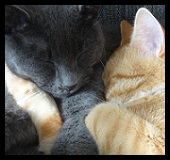|
 If your cat is not peeing, eating, or drinking, GO TO THE VET RIGHT NOW. Don't stop to ask the internet, just go. Any of these things can cause liver damage and death, and indicates a serious problem that needs to be treated immediately. If your cat is not peeing, eating, or drinking, GO TO THE VET RIGHT NOW. Don't stop to ask the internet, just go. Any of these things can cause liver damage and death, and indicates a serious problem that needs to be treated immediately.  Welcome to the Pet Island new kitten ownership thread. Whether you’re new to Pet Island or not, this is your one-stop-shop for information on adopting a kitten (or two; read further to learn why you should always adopt in pairs), or for advice for new kitten owners. If, after reading this thread thoroughly, you still can’t find the answer to your question, feel free to post for advice from those of us who have owned cats forever.  I know there is a TON of information in here, and I know this much writing can be overwhelming. However, please search through the OP’s for the answer to your question before posting. Because there is so much info here, chances are your question’s already been addressed. I know there is a TON of information in here, and I know this much writing can be overwhelming. However, please search through the OP’s for the answer to your question before posting. Because there is so much info here, chances are your question’s already been addressed. Here are the rules from Gobble’s Kitten FAQ thread; they apply here as well. I’ve taken the liberty of substituting “kitten” for “puppy” and “cat” for “dog” so as to avoid confusion: GobbleDeGook posted:First some rules, Next, Cuddlebottom talks about some bad reasons to get a puppy. This advice is really really really sound for all animal adoption, so it bears repeating here. Again, I’ve substituted the correct noun for this FAQ: ”Cuddlebottom posted:Bad Reasons for Getting a Kitten BOrangeFury posted some fabulous information regarding common substances that are poisonous to dogs. I’ve included them all in here; if you know for sure and can show me proof that any of the below substances are not poisonous to cats, let me know and I will remove it from the post. BOrangeFury posted:
Alright, now that we’ve shared the cross-thread info, let’s dive into kitten goodness! Why shouldn’t I adopt just one kitten or cat? Captain Foxy posted:If you're going to get a kitten; Get two. Nonanone and Women’s Rights? give some great reasons to consider adults over kittens: nonanone posted:Adult cats are awesome! They're chill and laid back, and adult can mean as young as a year old if you still want that kitten energy. Past the kitten stage, way less work, good for people who have less time or don't have easily kitten-proofed houses, or just don't want to deal with kitten-assholeness. Women's Rights? posted:Why are older cats better than kittens? Kittens, for one, are assholes. The only reason they are so incredibly adorable is so that you don't drown them when no one is looking. Kittens do not yet know how to use their claws or have things like bite inhibition, so they will bite and scratch you and it hurts, their claws and teeth are like tiny needles against tender human flesh. Kittens are endless fountains of energy and want to play. A lot. All the time. They will attack your feet or chew on your face in the middle of the night. They will chew on every cord in the house if given the chance. They climb on absolutely everything and constantly test their boundaries. Also, I want to add, adopting a pair of bonded cats is a huge blessing for shelters. Cats who come to shelters together or who have grown attached to each other in the shelter often can’t be adopted out together. That’s horrible for the cats, who are used to being together, and it leaves the shelter with an unhappy cat that misses its friend or littermate. So, not only would you be doing the cats a favor by adopting them together, you’d also be benefitting the shelter. I found a breeder of Bengals/Rag dolls/Persians/whatever cat you adore; how can I tell if they’re reputable? First off, you need to determine why you want a particular breed. Cats are not like dogs; there are not a zillion different breeds that still fit under the species Felis catus or domestic/house cat. For the most part, there are only small differences, like head shape, between breeds. Most of what distinguishes different breeds is the coat length, texture and color. That said, the first place you should check is your local shelters and rescues. Start with the shelters, since the cats there are in desperate need of adoption, and may be euthanized if they don’t find a new home. Most rescues will keep cats indefinitely. If neither the shelters nor the rescues yield the variety of cat you’re looking for, don’t forget PetFinder! If you simply cannot live without the particular breed of cat that strikes your fancy, and you find a breeder, go ahead and post about them in this thread . There are plenty of very experienced folks here who will be able to help you determine if they’re reputable. All right, I have a couple of kittens or cats. Now what? The next section includes all sorts of advice in the training, feeding and care of your new pets. There is a lot of great information here; please take the time to read through it thoroughly. Chances are your immediate questions are covered in this section. Training ”nonanone” posted:Kittens who bite and scratch hands/feet/body parts when they're young may be cute, but when they are 10+ pounds of pure cat, you will regret it. Usually caused by removal too early from the rest of the litter, but sometimes they just don't get the hint. The best way is to yelp loudly and sharply when injured even slightly, and redirect their attention towards appropriate things like toys. Susan B. Antimony posted:"Oh, but it's so cute when he plays with that power cord/my ipod cable!" Please note, the above post also applies to your hands/other family member’s hands. If your adorable baby kitten gets used to playing with hands, and it doesn’t hurt now when she does so, guess what? In a few months, it will hurt, and you’ll have a lot harder of a time training her away from it than you will if you start early. Women's Rights? posted:Declawing alternatives: Unagi posted:I would like to recommend something for the "Alternatives to Declawing" bit: Sidenote: The most commonly recommended place on PI to get scratching posts is Armarkat. I, and many other PI cat owners, have Armarkat posts, and praise them highly. Plus, they’re at least half, if not more, the price of the less cool versions most pet stores carry. Peech posted:Some grooming stuff! Many people, myself included, find that human nail clippers are not as good for trimming cat's claws, as the claws are prone to splinter from the clippers. Unless you know exactly what you're doing and can confidentially avoid causing issues with your kitty's claws, your best bet is to get a pair of trimmers made for cats (the shape of the blades will be different from human clippers). Shebrew posted:I thought I would help contribute by linking to and explaining some of the popular cat-related items that PI goers generally recommend. Firequirks posted:I started writing this and then I had totally different categories than what I had originally wrote, whoops. I hope this is good, but please feel free, anyone, to re-combine, re-write, correct, whatever. Consider this a starting point for this section, I am by no-means an expert. anachrodragon posted:On this note, I think this one is fairly common: wraithgar posted:This is a cousin of the same issue Spay/Neuter Chairman Meow was awesome and made a site with information on free or cheap spay/neuter clinics by state. You can find it here. Somebody fucked around with this message at 20:54 on Feb 21, 2013 |
|
|
|

|
| # ? Apr 25, 2024 01:19 |
|
FoodFire In The Disco posted:Let's talk about food. Of course, the Pet Nutrition Megathread has a whole poo poo-ton of food options, but let's focus for a second on why so many PI regulars advocate a grain-free diet for cats. Even though it was made by Purina, who has pretty  DISCLAIMER: At the end of the day, you should ask your vet if you’re concerned about your cat’s weight, in either direction. I can't find a brand from the Nutrition Megathread locally, and I don't want to pay for shipping! What now?  Fire In The Disco posted:Personally, I am a fan of independent pet stores. These are places like small pet supply stores, tack and feed shops, etc. There are a few reasons why I prefer these stores over big box stores like PetCo, PetsMart, etc. Ceridwen posted:As another bonus, almost all of the independent stores I've had experience with are directly involved in rescue. And they usually have ties with multiple groomers/trainers/vets etc. Where Petsmart et al. tend to direct you to their own services (which are usually not that good). d8 is our resident catnip expert. He sells wonderfully potent Montana catnip over in SA Mart if you're interested in picking some up! d8 posted:
Introducing a new cat to your other cats Eggplant Wizard posted:When you bring a new cat into your household, both it and your other cats will probably be upset. You would be too if someone thrust a roommate on you. You can minimize the stress by making the introduction gradually. Lifestyle ”Fire In The Disco” posted:
Sekhmet posted:I think the indoor/outdoor debate is kind of a personal and cultural issue, but I just wanted to link to the Ohio State University CVM's Indoor Cat Initative website, in case you want to add it to the FAQ. nonanone posted:Reasons not to let your cat out: LoreOfSerpents posted:If possible, I would like you to add something to your cat FAQ post in PI, related to keeping cats indoors because of predators. Crooked Booty posted:Collars, Tags, Microchips, Etc.: A popular variety of tags around here are Boomerang tags, because they sit flush to the collar. Not dangling down means the tag not falling into food or water, and also not getting easily caught. Susan B. Antimony posted:I'm going to start a litter box problems section here, but I can't hope to be comprehensive, so any and all of y'all please feel free to add. CrispyMini posted:Also try adding litter boxes with a litter alternative- we had a litter-protest going on that very nearly ended with getting rid of the cat, when we tried out a different litter instead. Oh joy, that immediately solved the problem!! New cat-owners should know that there are TONS of options for cat litters- clumping, non-clumping, clay, biodegradable, flushable, crystals, etc. Expensive doesn't always equal better, but you do need to have some kind of system that works well for cleaning and that you and your cat can agree on. As Susan B. Antimony mentioned above, Cat Attract litter is amazing stuff. I don’t think I’ve ever heard of a case of this litter not attracting the cat to use the box. I’m sure there’s an example out there, but they’re so few and far between that they almost don’t exist. Aerofallosov posted:Cleaning up! flyboi posted:Can you put this stuff somewhere in the op? I see tons of posts recently about cats peeing where they shouldn't. Your cats’ health Crooked Booty posted:Two health problems all cat owners need to know about : Khelmar posted:Part taken from my post in the dog FAQ thread. Suggestions welcomed. I swear I read the entire zillion-word FAQ, and I can’t find the answer to my question! Though rare, this might happen from time to time. Meow Cadet sums up what to include in your post when you have a question for us. Meow Cadet posted:It can be annoying to ask for basic info over and over someone has a problem. You might think about stressing what standard to provide. Maybe something like: If you're reading this sentence, you made it! You've now finished unearthing a veritable treasure trove of information about cat care. Thanks for taking the time to read this FAQ. Don't you feel smarter already?? Oh, nearly forgot. One last piece of wisdom: aunt moneybags posted:We need to add "Cats are weird. Get over it" to the FAQ. Somebody fucked around with this message at 19:51 on May 7, 2023 |
|
|
|
Great job with the thread, just in time for my new kittens arriving monday! I'm thinking about getting one of the Armarkat trees, but I can't choose! Which do you all think would be best for two cats? I was looking at http://www.armarkat.com/classic-cat-tree/classic-cat-tree-a7802/prod_29.html but it may be overkill. Also, are the premium versions actually worth it? They claim better materials and sturdier trees. edit: I also found armarkat cheaper at a few places such as allpetfurniture.com 149.99 for the one I linked vs. 169.99, any downside to buying from a third party? JayJay fucked around with this message at 14:03 on Jul 12, 2009 |
|
|
|
JayJay posted:Great job with the thread, just in time for my new kittens arriving monday! I'm thinking about getting one of the Armarkat trees, but I can't choose! Which do you all think would be best for two cats? I was looking at http://www.armarkat.com/classic-cat-tree/classic-cat-tree-a7802/prod_29.html but it may be overkill. As for third parties, check ebay. You'll find them on ebay for <$20 bid, where the bulk of the cost will be shipping (or so they say). Either way, I got that tree brand new for less than $100 on ebay including shipping, and several other PI people have done the same thing. You can usually save quite a bit of money. 
|
|
|
|
JayJay posted:Great job with the thread, just in time for my new kittens arriving monday! I'm thinking about getting one of the Armarkat trees, but I can't choose! Which do you all think would be best for two cats? I was looking at http://www.armarkat.com/classic-cat-tree/classic-cat-tree-a7802/prod_29.html but it may be overkill. Thanks.  I have that tree too, and my cats adore it. And the faux fur is easy to clean, like Crooked Booty said. Definitely check out their eBay store, but here's another vote for that particular tree. 
|
|
|
|
How is feeding kittens different from feeding adults in terms of amounts, timing, etc.? Do they need a different type of food than adults?
|
|
|
|
Most premium and ultra premium foods are good for both kittens and cats. Typically they'll say it on the bag/can. As far as dry food goes, I've always been a proponent of free feeding kittens until around a year old, because they need way more food in a day than adult cats do, and then gradually weaning them over to twice daily feedings. For wet food, the can will say how much to give the kitten, typically based on weight.
|
|
|
|
Fire In The Disco posted:Food Those are fine, but these ones from LuckyPet are much cuter.
|
|
|
|
I mentioned the Cat Attract litter! =p Great Job, Fire. Super awesome OP. Oh, and on the Armarkat thing--I got the premium fleece, and my cat wants to eat it. -.- YMMV.
|
|
|
|
All of the foods that BOrangeFury listed as poisonous to dogs are indeed poisonous to cats. Another good one to specifically mention might be houseplants. Tons of common houseplants are poisonous, and some cats love to eat plants. A neighbor of mine just had a near-death kitten experience after their kitten managed to get a piece of a hanging azalea on their porch. Here is the ASPCA database of plants.
|
|
|
|
tse1618 posted:Those are fine, but these ones from LuckyPet are much cuter. Oh those are so cute.
|
|
|
|
Yes, my cat has one and I'd take a picture of it, but personal details and all. The fasteners are like rubber bands that are melded onto the back of it, so you just stretch them out and slide the collar through them. They're pretty thick and strong, so you don't have to worry about them snapping. It doesn't move around on the collar at all or make any noise.
|
|
|
|
human nail clippers imo are not ok to clip cat's nails as they'll splinter them.
|
|
|
|
Susan B. Antimony posted:I mentioned the Cat Attract litter! =p Great Job, Fire. Super awesome OP. Oh, and on the Armarkat thing--I got the premium fleece, and my cat wants to eat it. -.- YMMV. bamzilla posted:human nail clippers imo are not ok to clip cat's nails as they'll splinter them. Fixed and fixed. 
|
|
|
|
A note about laser pointers: use the weakest red one you can find, and don't use them on reflective surfaces like tiles. If possible only use them on carpet. While pretty much every cat goes nut for the red dot at the end of the session they lack a sense of achievement. So what I do at the end of playing time is throw a small red ball for my kittens to catch.
|
|
|
|
We found a kitten by the trash about a little less than a year ago. Ever since we got him we can't get him to stop sucking on and licking people. I know this is because he was abandoned by his mother (he was three weeks old when we found him) but its really weird to have your cat lick and suck on your guests. Also, he will only do this to human skin, not clothes or blankets, so we can't exactly spray ourselves down with bitter apple. He is a male neutered indoor cat, and will be a year old in October we think. We only have the one cat because we are living in a foreign country at the moment and don't think a second cat would be a good idea until we go back to America. Advice? Beldaran fucked around with this message at 04:28 on Jul 17, 2009 |
|
|
|
Beldaran posted:We found a kitten by the trash about a little less than a year ago. Ever since we got him we can't get him to stop sucking on and licking people. I know this is because he was abandoned by his mother (he was three weeks old when we found him) but its really weird to have your cat lick and suck on your guests. Also, he will only do this to human skin, not clothes or blankets, so we can't exactly spray ourselves down with bitter apple. Hwaa! My cat does this too. Except he's 11 weeks old and not abandoned by his mother. I am curious to see if anyone has a super awesome answer to your question as I'd like to know what the gently caress that is about as well.
|
|
|
|
Read the whole FAQ, certainly some interesting things that I didn't know about. Thanks! Definitely got to find someone that sells something like SSScat in this country.
|
|
|
|
Beldaran posted:We found a kitten by the trash about a little less than a year ago. Ever since we got him we can't get him to stop sucking on and licking people. I know this is because he was abandoned by his mother (he was three weeks old when we found him) but its really weird to have your cat lick and suck on your guests. Also, he will only do this to human skin, not clothes or blankets, so we can't exactly spray ourselves down with bitter apple. jacido posted:Hwaa! My cat does this too. Except he's 11 weeks old and not abandoned by his mother. I am curious to see if anyone has a super awesome answer to your question as I'd like to know what the gently caress that is about as well. Unfortunately, I have never heard of a way around the suckling, unless you can redirect them to an inanimate object of some sort. Your cats might outgrow it; my kitten Luna did a lot of suckling when we got her at 5 weeks old, but doesn't do it anymore. I also have an adult cat who licks everyone, no matter what we have tried to stop him. So, you guys might be stuck with the habit. Sorry! v
|
|
|
|
Fire In The Disco posted:Your cats might outgrow it One of my cats suckled everything - including people and other cats - as a kitten and gradually reduced this as he got older. Now he's around 3-4 years old and suckling is reserved only for my soft dressing gown and two particularly soft throws on my bed and sofa. I don't think he'll ever completely stop  And he wasn't abandoned by his mother or anything, he was certainly over 12 weeks when we got him. And he wasn't abandoned by his mother or anything, he was certainly over 12 weeks when we got him.
|
|
|
|
My cat licks people all the time and they generally find it endearing.
|
|
|
|
Puppy Galaxy posted:My cat licks people all the time and they generally find it endearing. My cat licks everything that smells like human. She particularly loves our legs right after my boyfriend or I get out of the shower. She's a weirdo. She also is polydactyl. And a question, because I feel that my cat is bored during the day (I was in college and could give her a lot more attention, but now I'm working full-time and I feel like she's really, really lonely). We're moving into a bigger place in September and I am trying to convince the boyfriend to get another cat. - Age: Not sure, we found her in the street. Probably around 3 or 4. - Sex: F - How long have you had your cat? Almost a year - Is your cat spayed or neutered? Of course - What food do you use? Wellness Salmon - When was your last vet visit? Almost a year ago, time for a checkup once we move. - Is your cat indoors, outdoors, both? Indoors. - How many pets in your household? Just her. - How many litter boxes do you have? One. The only caveat is that any new cat would have to be a tortie, since my boyfriend is allergic to normal cats but has no issues with torties. So: 1. Is it a good idea to get a companion? (Petfinder seems to have plenty torties around, since it's kitten season.) 2. How old / what gender? I'm not TOTALLY against dealing with a kitten, but if they're agreeable enough I'd want an older cat. 3. How should I introduce them? (As much as I would like to bring her in and have her meet any new cat in the shelter, I feel like she would be way too freaked out about being in a carrier to actually like anyone.)
|
|
|
|
Well, first off, Tortie is a color pattern, not a breed/hairtype, so your boyfriend probably has just acclimated to your current cat. Having said that, you may want to just want to visit the shelter and see which current cat sets off his allergies the least. I've had no problems integrating both girls and boys (speuters though), and I find that the most differences come in the individual cat personalities, and gender is a lesser determinant. Age, also, I think it depends on the cat. Some older cats act like kittens, some kittens are quieter and better mannered. A companion for your cat sounds like a great idea though.
|
|
|
|
Seconding what nonanone said about torties not being a breed. That can't possibly make a difference in allergies.Nicol Bolas posted:1. Is it a good idea to get a companion? (Petfinder seems to have plenty torties around, since it's kitten season.) 1. Always  unless you know she has a history of not getting along with other cats. unless you know she has a history of not getting along with other cats. 2. It might be easier to introduce a younger cat to her so she does not feel threatened. I say this based on my personal experiences, which have always been that queens are pains in the butt about other cats. This is only based on four though. Your tortie might be nice. 3. We definitely need an introduction post. I will do my best, but I have less experience than most so I'll be mostly parroting stuff I've learned from PI. Please add/edit as necessary. Introducing a new cat to your other cats When you bring a new cat into your household, both it and your other cats will probably be upset. You would be too if someone thrust a roommate on you. You can minimize the stress by making the introduction gradually. Stage 0: Acceptance of terms There will be lots of hissing. This does not mean you are doomed. Stage 1: Seclusion Keep the new cat separate from the other cat(s). Make sure it has all the necessities- food, water, litter, attention. Choose somewhere you can hang out with new cat and get to know it, but not your other cat's favorite hangout, either. The cats will all know the others are there, but this stage allows them to get comfortable with there being other scents around. Try switching out each cat's bedding so they can sniff at it. You might also try giving them their meals on either side of a closed door, so they associate food with the new cat's smell. You can switch the cats out to explore each other's areas and get used to scents & places that way, too. This stage can last a couple of hours to a week or so. You will have to use your judgment on when to advance. If both cats seem comfortable and curious, rather than totally anxious, continue on. Stage 2: Supervised introductions Pretty much what it says. Let the cats meet. There will almost certainly be hissing and maybe even some swatting. It's okay to laugh when their tails puff up. You can let these introductions last as long as you like, depending on how the cats interact. The rule of thumb is not to separate them unless (a) you can't be present to supervise anymore or (b) violence erupts. Violence is not swatting and hissing and puffing up, or even growling and yowling, necessarily. If blood is drawn or the yowls seem to indicate pain rather than aggression, then it's absolutely time to separate them and return to stage 1 for a while. This stage might last as little as one or two meetings, or it could go on for weeks. If it drags beyond a week please ask and see if we can make some suggestions to make things go more smoothly. Stage 3: Kitten piles As the introductions go better and last longer without incident, you will feel comfortable leaving the cats alone, and from there they'll probably soon reach a level of toleration, if not immediate kitten piles. Kitten piles may never happen, honestly, and that's not your fault. If they do, great!
|
|
|
|
Just a note to add to the supervised introduction: Bring some toys as a distraction! I always use a laser pointer during introductions because they are so focused on playing, that they kinda forget the other cat is there or even start playing together. It has always helped in my experience.
|
|
|
|
Pragmatica posted:Just a note to add to the supervised introduction: Bring some toys as a distraction! I always use a laser pointer during introductions because they are so focused on playing, that they kinda forget the other cat is there or even start playing together. It has always helped in my experience. I usually use treats as well. I'll sit on the floor and put a treat on each side of me and then continue giving treats, moving them closer and closer, until they're sitting next to each other waiting for more treats. This usually either ends up in them being completely unconcerned or one of them suddenly realizing I've tricked them into sitting next to that other cat! and hissing and running off. Over time I've found it to be effective however. I was doing this the other night with Iggy and Ramona and she started cleaning his face for him, whereas the day before she'd been hissing at him if he got within a foot of her and she wasn't on higher ground.
|
|
|
|
I had an absolute breeze of a time bringing in a new kitten a few weeks ago. She actually ran up to one of my other cats and just started licking him. He, and the others, didn't know how in the world to react to it, and they pretty much instantly accepted her as a new annoyance. It was a little mix of cute and odd.
|
|
|
|
Ok I have a question I haven't been able to get answered with google and then a question that I'd like to know about. It's a 3-4 month old kitten that's currently on Innova. It's an indoor cat, but lives with a cat who likes to stay outside half an hour a day and sit under the porch and a dog who goes outside to poop. Anyway. 1. The vet says for the entire life of the kitty I have to buy Multi Advantage. When we got him he had a ton of problems, fleas, mites, and worms and still has mites (we're putting 4 drops of tresaderm in his ears twice a day). It looks to be for fleas, worms, ticks, and mites but he's a mostly indoor cat. They said that I have to get it for every single month for the rest of its life. I don't mind blowing $18 more a month on the kitty to keep it healthy, but if it's not needed then I don't want to bother. It doesn't hang outside but one cat does love to go outside and sit under the porch for a bit and paw at the doors to get back in after he's amused himself enough. Oh and the kitty had mites cause we rescued him from a house where there were a lot of kittens in dire need of care. 2. The vet said soft paws don't work and come off easily and that declawing is the only option. She said that declawing comes standard when they neuter them and they prefer not to neuter without doing a declawing too and they rarely don't declaw cats. She also said trimming the nails won't work because they'll be sharp within a day, so you'd have to trim them everyday. I can kind of tell that she's pushing the procedure for the money which I don't want to do or she's just stupid. The big thing is, I can get like 4-5 years worth of Soft Paws for a declaw and if they really do stick I'd prefer to do that. Can cats really sharpen their nails within a day? So in summary, do I need to buy multiadvantage every month of the cats life and do soft paws work and can cats really sharpen their claws in a even after you trim them?
|
|
|
|
Xerin posted:So in summary, do I need to buy multiadvantage every month of the cats life and do soft paws work and can cats really sharpen their claws in a even after you trim them? Even if your cat doesn't go outside you and your other pets can bring fleas and other parasites inside. that's why the vet is pushing that. As for the declaw thing, I'd seriously change vets if mine said that it "comes standard with neutering." If your cat is still young you can easily train it to let you trim their claws. I trim my tabby's claws about every week just to keep them blunt.
|
|
|
|
Xerin posted:Ok I have a question I haven't been able to get answered with google and then a question that I'd like to know about. Declawing as a standard? What the fuuuuuuuuck? For the MONEY??? Edit: Sorry, was too miffed to write anything useful. My mom's cat is psychotic so she gets her claws trimmed at the vet. I think she has to do it every few weeks. So no, they certainly cannot resharpen them in a day. I haven't used Soft Paws myself but people on the forums that use them have had good results it sounds like. I'd think that just keeping their claws trimmed would be less work but eh. Why are you asking anyway? Is the cat ripping up stuff already (couches, people)? There are lots of ways to just train cats to not do naughty stuff so if you haven't exhausted those yet, I think there's some help for that posted in the FAQ. I'd get a second opinion about the flea medicine too since this psycho seems to see your cat as little more than a furry dollar sign. HondaCivet fucked around with this message at 04:23 on Jul 25, 2009 |
|
|
|
HondaCivet posted:Declawing as a standard? What the fuuuuuuuuck? For the MONEY??? They have a combo package, you get charged more for the neuter if you don't do the declaw. It's like $60 for the neuter and $140 for the declaw or together as a package you get the neuter for $40 and the declaw for $120 (or $160 total saving you 40 bucks). They said it's hard to remember someone who doesn't get the combo because it just makes sense cost wise and it's the right thing to do for the animal. She actually got testy with me when I said I didn't want to do it and would rather just cover them or trim them. The kitty doesn't mind if I expose his claws. He just looks at me while I press on them. The cat isn't doing anything with the claws yet, but I live in a house with someone who doesn't want to run the risk of getting their furniture torn up and wants to be sure the cat doesn't start to shred curtains or sofas. Yuriki fucked around with this message at 04:26 on Jul 25, 2009 |
|
|
|
Xerin posted:So in summary, do I need to buy multiadvantage every month of the cats life and do soft paws work and can cats really sharpen their claws in a even after you trim them? You do not have to buy Advantage Multi specifically, but you should keep your cat on flea prevention and heartworm prevention as well if you live in an area that has high rates of heartworm (much of the US). This will mean spending $11-20/month. Yes, soft paws really do work, no cats cannot sharpen their claws in 1 day, and you should be running away from that vet as quickly as you can. I trim Eowyn's claws about once every 2 weeks and she never claws anything except her scratch posts and the mats we keep by the doors that she's allowed to scratch on ($10 Ikea mats). All it took was a little patience to train her. Here is the American Veterinary Medical Association position statement on declaws: http://www.avma.org/onlnews/javma/apr03/030415c.asp The position is not even particularly strict (compared to what is acceptable in many countries) but your vet is way outside of this into pushing declaws and denying that it is possible to train a cat not to claw.
|
|
|
|
You might want to just start by trimming the claws and use soft paws if the cats starts clawing furniture. My cats never claw any furniture except a sofa I have from the 70s. Since the cat is already letting you manipulate its paw you shouldn't have any problem trimming the claws. Also make sure you have a scratching post or two and train the cat to scratch that. The only cats we had that scratched furniture were the ones that didn't have scratching posts as kittens. And your vet sucks. Get a new one.
|
|
|
|
Xerin posted:They have a combo package, you get charged more for the neuter if you don't do the declaw. It's like $60 for the neuter and $140 for the declaw or together as a package you get the neuter for $40 and the declaw for $120 (or $160 total saving you 40 bucks). They said it's hard to remember someone who doesn't get the combo because it just makes sense cost wise and it's the right thing to do for the animal. Wow, she seriously sounds messed up. Does she get off on cutting off little kitty toes or something? I'd go elsewhere. Fast. Oh, and if you dido't know, declawing basically removes the last digit of their paws, which is like cutting off the tips of your fingers. Many view it as pretty goddamned inhumane. Lots of rescues and shelters won't allow a cat to be adopted out unless the owner agrees not to declaw it. Many countries around the world have made declawing illegal. It is great that you think your cat deserves to keep its paws whole though. Pretty much every cat owner has to deal with the fact that the cat might think the couch looks like a cool scratching post. There are plenty of tools and techniques available that leave cat, owner and couch happy.
|
|
|
|
Thanks for all the comments. So I can just get a flea and heartworm medicine and save a little bit of cash? That sounds good. Well, I kind of figured she was a 'lil crazy when she told me that you shouldn't feed cats wet food because it'd cause urinary infections and that it won't have his teeth past the age of 3 and the only food I should feed it is Purina Pro Plan. I told her I was feeding it Innova and she told me it might die because that food doesn't meet the proper inspection that Purina gives all of its food, but she'd be there whenever it got sick because of my poor decisions. I shrug'd that off as corporate shilling though. I'll probably drive 20 miles or so to go to a different vet from now.
|
|
|
|
This vet is thread worthy, that is batshit
|
|
|
|
ChairmanMeow posted:This vet is thread worthy, that is batshit Yes, please post every crazy rear end thing she said, she sounds like a goldmine of horrible.
|
|
|
|
It was already bad enough when it was just pushing declawing, but knocking innova for purina? Is there some sort of vet board you can report her to?
|
|
|
|
ChairmanMeow posted:This vet is thread worthy, that is batshit I made a thread here to avoid making GBS threads up this thread about pyschovet anymore and from the Pet Nutrition thread it seems like a lot of other people have lovely vets who recommend the craziest poo poo.
|
|
|
|

|
| # ? Apr 25, 2024 01:19 |
|
I just wanted to chime in and say Thank You! This thread is better than most "General Cat" info dumps I have found on the net. My daughter would like a kitty, and I would also but I was waiting for her to get old enough to not have to worry about her being over powered by the mighty feline. This has been a huge goldmine of getting me prepared! I will be getting a Ssscat, that poo poo is hilarious! I would also like to say someone must be pushing the de-clawing info to some vets because we I went to interview and talk to my local vet she also was trying to push it as a "Basically required" form of cat care. What the hell, these people are supposed to be properly informed. Ol Junebug fucked around with this message at 15:53 on Jul 25, 2009 |
|
|






 plus a poo poo TON of paper towels.
plus a poo poo TON of paper towels.






















